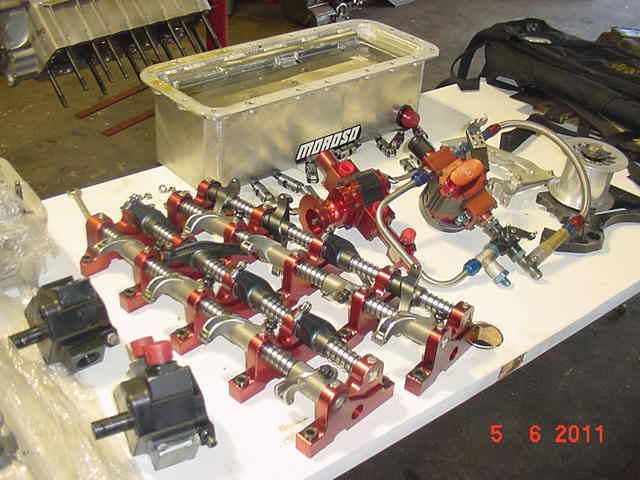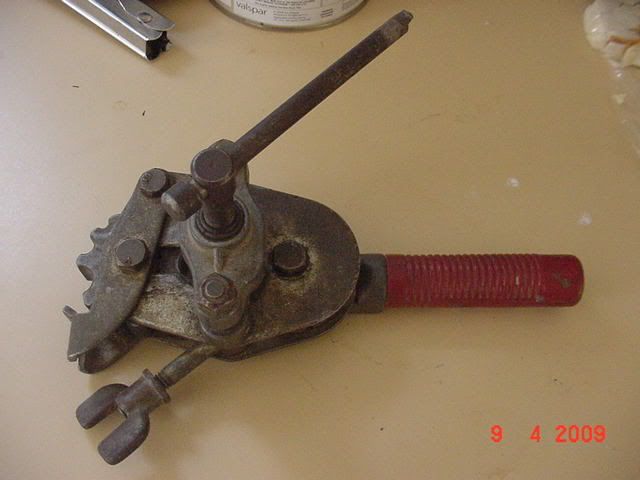You are using an out of date browser. It may not display this or other websites correctly.
You should upgrade or use an alternative browser.
You should upgrade or use an alternative browser.
looking for an AN-4 flare tool.
- Thread starter FORANE
- Start date
Look at some racing shop websites like summit racing for 37 deg flare kits. They usually have kits around $30-$40 to use on AN fittings used on race cars. Cheaper but they work good with the right tube prep.Any suggestions for an AN-4 flare tool that's reasonably priced and acceptable quality for low usage?
Any suggestions for an AN-4 flare tool that's reasonably priced and acceptable quality for low usage?
I have been in the tubing flaring business for 35 years(LP Gas and racing). Have done a lot of flaring with many different tools. The best flaring tool I have I got from Snap On along time ago and is a Imperial Eastman. It is a 45° tool. I have used it for many years to make 37° flares on race car plumbing, even hard stainless tubing. When you tighten the fitting the tubing seals to the 37° flare. I know it is not best but worked fine for many lines on some very fast dragsters running 10K rpm supercharged hemis.
But I don't cut corners when it comes to airplanes, they scare me too much. Unfortunately even though you need it for low volume work doesn't mean you should or can use a cheap tool or one that does 45° flares.
A cheap tool damages the flare right at the base of the flare and then it is more prone to cracking.
A good tool creates a smooth radius at the base of the flare to reduce the chance of cracking from vibration.
This is a tool I'd recommend for aviation work. https://www.aircraftspruce.com/catalog/topages/hidutyflaringtool.php?clickkey=14853
This is a fuel pump off one of my dragsters with stainless bypass tubing that I made with a 45° flaring tool that are 37° fittings.

Capt. Geoffrey Thorpe
Touchdown! Greaser!
- Joined
- Jun 7, 2008
- Messages
- 15,637
- Location
- DXO124009
- Display Name
Display name:
Light and Sporty Guy
FWIW: https://www.aircraft-tool.com/shop/detail.aspx?id=212FB
Works for me...
Works for me...
Have plenty of them, one in each service truck.


Last edited:
Have plenty of them, one in each service truck.
Wow, looks like it's been in service a while.
If talking about the AN819 sleeves then yes as AN818 B nuts will not work without them and both are reuseable. There are various guidance ref that explain in more detail. And as to the 37 deg vs the 45 deg points being made while in theory it will work, in my experience with aircraft I've repaired a lot of 45 deg failed flares on aircraft. The main reasons they fail is the small bearing surface of the 819 sleeve creates a stress point on the 45 deg flare when torqued (or overtorqued) to make the fitting seal. The other reason is that most aircraft tubing remains in place for longer periods vs other applications which give more time for those stress points/overtorqued fitting to reach their failure point. And just to add, I've used cheap to expensive flare tools that if you don't prep the tube properly prior to flaring it can lead to flare issue regardless of flare tool type.Are tube sleeves beneficial in flared fittings or no?
If talking about the AN819 sleeves then yes as AN818 B nuts will not work without them and both are reuseable. There are various guidance ref that explain in more detail. And as to the 37 deg vs the 45 deg points being made while in theory it will work, in my experience with aircraft I've repaired a lot of 45 deg failed flares on aircraft. The main reasons they fail is the small bearing surface of the 819 sleeve creates a stress point on the 45 deg flare when torqued (or overtorqued) to make the fitting seal. The other reason is that most aircraft tubing remains in place for longer periods vs other applications which give more time for those stress points/overtorqued fitting to reach their failure point. And just to add, I've used cheap to expensive flare tools that if you don't prep the tube properly prior to flaring it can lead to flare issue regardless of flare tool type.
The fittings I worked with an819 sleeves are all 37° fittings. I only meant I used a 45° tool to make the flare and let the an819 sleeve finish making the last 7° of flare when tightened up. Not saying it is right or OK. Just that I got away with it on race cars.
I would not use a 45 tool for a 37 fitting on a aircraft.
#4 an is the smallest that you can use a sleeve I believe? If you go to #3an then it is a different kind of fitting and hose.
I believe 37° fittings have more contact area so they are used for higher performance applications?
Like said you must use the sleeve as it mates with the nut that is designed to give you a better more supportive fitting.
I have never seen a sleeve used on a 45° flare nut like we use on LP gas with soft copper tubing.
Aluminum, is that what was used from the factory? Aluminum is more prone to cracking is why I ask.
Last edited:
Wow, looks like it's been in service a while.
We wear them out, I bet that one has been replaced by now. That is a good tool though.
Aluminum, is that what was used from the factory? Aluminum is more prone to cracking is why I ask.
It is for Lycoming oil drain tubes.
And if you race dragster you likely know Gene Fulton. Gene is a pilot and he's done some welding for my lancair.
This is something that always needs to be re-enforced. Years ago I helped the local race guys with aircraft supplies as I had many sources. Now it seems speed shops have a better AN selection and price than the aviation side. However, this continued “melding” of car vs aircraft parts keeps the 45 deg/37 deg issue alive unfortunately.I would not use a 45 tool for a 37 fitting on a aircraft.
AN818/819 fittings start at a -2 or 1/8 tube size. There is guidance that states soft metal tubes below a certain OD should have a double flare but they still use the same fittings. I found as long as you use a 5052 tube material vs a 1100 or 3300 material a single flare will still work at the -2 or -3 size provided it is formed/installed properly.#4 an is the smallest that you can use a sleeve I believe? If you go to #3an then it is a different kind of fitting and hose.
That is my understanding along with higher connection strength and the same reason industrial hydraulic fittings are 37 degree as well.I believe 37° fittings have more contact area so they are used for higher performance applications?
Yes. You will see steel or titanium lines in certain circumstances but tube material is based more on system pressure or fluid type with aluminum alloy tubing the most popular. As to failure that is more a result of system design, installation issues, or improper mx. Even some high pressure hydraulic tubes are made from aluminum but of a higher hardness like 6061 and use different MS type fittings. However, Skydroil hydraulic system require SS lines due to the corrosive nature of the fluid.Aluminum, is that what was used from the factory? Aluminum is more prone to cracking is why I ask.
I have lots of an fittings for race cars, the good ones use a cutter design that cuts into the braided rubber hose to offer double gripping power, not just a single compression. The good ones are also hard anodized.
When I made new oil and fuel lines for my plane I still ordered my fittings from Spruce. I want nothing but aviation stuff on my plane, no short cuts or race car parts on my plane.
Did have a fair amount of aircraft hardware on our top alcohol dragster, some of it is titanium. We wanted to be like a plane and fly!, lol
I have a simple test rig setup to test and tag my lines I make with either CO2 or nitrogen. We were required by the NHRA to test and document every line on our cars to prevent oil downs and crashes.
plus I have been building LP gas hose for many years.
I take aviation mechanics very seriously. I am not a AP but do work very closely with mine.
At the hangar now after work, time to go fly!!
When I made new oil and fuel lines for my plane I still ordered my fittings from Spruce. I want nothing but aviation stuff on my plane, no short cuts or race car parts on my plane.
Did have a fair amount of aircraft hardware on our top alcohol dragster, some of it is titanium. We wanted to be like a plane and fly!, lol
I have a simple test rig setup to test and tag my lines I make with either CO2 or nitrogen. We were required by the NHRA to test and document every line on our cars to prevent oil downs and crashes.
plus I have been building LP gas hose for many years.
I take aviation mechanics very seriously. I am not a AP but do work very closely with mine.
At the hangar now after work, time to go fly!!
Last edited:
It is for Lycoming oil drain tubes.
And if you race dragster you likely know Gene Fulton. Gene is a pilot and he's done some welding for my lancair.
Heck yea the oil return lines are aluminum on my 0-320 but are #6 or 8. I forgot a about those. On my old motor I replaced the rubber hose and clamps on the return lines. Good luck with it.
I wish I could have used just nitrogen to proof check lines and hoses. Unfortunately for some I needed 2000 psi to proof test which I did with a DIY hydraulic hand pump set up.I have a simple test rig setup to test and tag my lines I make with either CO2 or nitrogen.
Let'sgoflying!
Touchdown! Greaser!
Der Fliegermeister
Pre-takeoff checklist
- Joined
- Apr 9, 2021
- Messages
- 196
- Display Name
Display name:
Bandit
For the love of God...do NOT use a 45 degree flare tool

